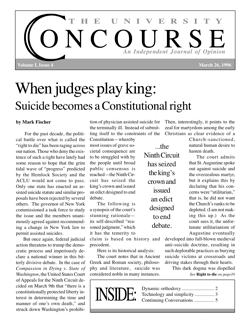When judges play king: Suicide becomes a Constitutional right
by Mark Fischer
For the past decade, the political battle over what is called the “right to die” has been raging across our nation. Those who deny the exis-tence of such a right have lately had some reason to hope that the grim tidal wave of “progress” predicted by the Hemlock Society and the ACLU would not come to pass. Only one state has enacted an assisted suicide statute and similar proposals have been rejected by several others. The governor of New York commissioned a task force to study the issue and the members unanimously agreed against recommending a change in New York law to permit assisted suicides.
But once again, federal judicial action threatens to trump the democratic process and imperiously declare a national winner in this bitterly divisive debate. In the case of Compassion in Dying v. State of Washington, the United States Court of Appeals for the Ninth Circuit decided on March 9th that “there is a constitutionally protected liberty interest in determining the time and manner of one’s own death,” and struck down Washington’s prohibition of physician assisted suicide for the terminally ill. Instead of submitting itself to the constraints of the Constitution—whereby most issues of grave societal consequence are to be struggled with by the people until broad public consensus is reached—the Ninth Circuit has seized the king’s crown and issued an edict designed to end debate.
The following is a synopsis of the court’s stunning rationale—its self-described “reasoned judgment,” which it has the temerity to claim is based on history and precedent.
Here is its historical analysis:
The court notes that in Ancient Greek and Roman society, philosophy and literature, suicide was considered noble in many instances. Then, interestingly, it points to the zeal for martyrdom among the early Christians as clear evidence of a Church-sanctioned, natural human desire to hasten death.
The court admits that St. Augustine spoke out against suicide and the overzealous martyr, but it explains this by declaring that his concerns were “utilitarian,” that is, he did not want the Church’s ranks to be depleted. (I am not making this up.) As the court sees it, the unfortunate utilitarianism of Augustine eventually developed into full-blown medieval anti-suicide doctrine, resulting in such deplorable practices as burying suicide victims at crossroads and driving stakes through their hearts.
This dark dogma was dispelled by the enlightenment, which tore at the superstitious underpinnings of the Church’s irrational opposition to suicide. By the nineteenth century, courts and legislators had stopped enforcing anti-suicide statutes. Now, (the court seems to say) the time has come to complete the “good work” begun at the enlightenment, and legally recognize everyman’s right to a comfortable death.
Liberal jurists, not generally known for their commitment to historical analysis, have evidently found that it can be quite useful in this age of deconstruction.
I doubt whether this is what Justice Scalia had in mind when he lamented Constitutional analysis divorced from history and tradition.
But here is the philosophy:
I quote: “We see no ethical or constitutionally cognizable difference between a doctor’s pulling the plug on a respirator and prescribing drugs to cause death.” Death results in both cases. Death is the intent in both cases.
Such unrespectable analyses give credence to the accusation that federal judges have taken on the role of amateur philosophers. Crucial, life and death distinctions agonized over by theologians, philosophers and medical ethicists are casually waved away by these judicial idealogues.
Further muddying the ethical waters, the court rejects the term “suicide.” Without saying exactly why or how, it asserts that “right to die” or “hastening one’s death” are more “accurate” terms. Indeed, it finds that the term suicide is not an “appropriate legal description of the conduct at issue.” (Too lucid, probably.)
Anyone else reminded of “pro-choice” instead of “pro-abortion;” “fetus” rather than “child”?
The Interests of the State:
Possibly the most disturbing aspect of the opinion is the court’s rejection of the state’s reasons for prohibiting physician assisted suicide. Every reason given is twisted into a reason for protecting the “right to die.”
The state argued that the disabled and poor will be vulnerable to those who see their lives as useless. The court found this argument to be a “recycl(ing of) one of the more disingenuous and fallacious arguments raised in opposition to the legalization of abortion.” As they see it, the real concern is that the disabled and poor “will not be afforded a fair opportunity to obtain the medical assistance to which they are entitled—the assistance that would allow them to end their lives with a measure of dignity.” And, in any case, they are confident that “adequate safeguards” will guard against the remote occurrences of abuse.
The state argued further that the medical profession will be compromised when physicians become killers. Dead wrong, said the court. First, the presence of impartial professionals will protect the vulnerable from abuse. Second, the medical profession is compromised, not by participation in this “humane” activity, but by criminal statutes that prevent it from fulfilling “professional obligations” and “make covert criminals out of honorable, dedicated, and compassionate individuals.” Finally, said the court, those who prophesy that physician assisted suicide will destroy the medical profession do not know their history. The same argument was used against the legalization of abortion, but “once the Court held that a woman has a constitutional right to have an abortion, doctors began performing abortions routinely and the ethical integrity of the medical profession remained undiminished… The slippery slope fears of Roe’s opponents have, of course, not materialized… The legalization of abortion has not undermined our commitment to life generally… Similarly, there is no reason to believe that legalizing assisted suicide will lead to the horrific consequences its opponents suggest.” (I quote at length lest I be accused of exaggerating.)
The precedent:
Although the court gave lip-service to the line of decisions regarding the refusal of medical treatment (with Cruzan being the principal decision), the focal point of its analysis of legal precedent was Planned Parenthood v. Casey, the controversial Supreme Court abortion decision in which Roe v. Wade survived by a single vote. In analyzing a person’s constitutional liberty interest, the Casey Court wrote that: “At the heart of liberty is the right to define one’s own concept of existence, of meaning, of the universe, and of the mystery of human life. Beliefs about these matters could not define the attributes of personhood were they formed under compulsion of the State.” This has become the mantra of constitutional law—the right to “define oneself” and the right to be left alone. No reference to the impact of individual actions on society as a whole. The uninhibited self is the sole arbiter of the validity of actions.
The Ninth Circuit endorsed this philosophy in its closing line: “Those who believe that death must come without physician assistance are free to follow their creed, be they doctors or patients. They are not free, however, to force their views, their religious convictions, or their philosophies on all the other members of a democratic society, and to compel those whose values differ with theirs to die painful, protracted, and agonizing deaths.”
The court personalized its painfully long analysis (I often wished the plug had been pulled on this opinion 40 or 50 pages sooner) with stories of individuals who could not obtain physician assisted suicides and were thus “forced” to kill themselves in horrible ways—shotguns in the mouth, leaps off bridges and plastic bags over the head. In the court’s view, the state’s unwarranted fears that some may be coerced into suicide cannot compare to the misery inflicted on these individuals and their families. And should a doctor misdiagnose a patient’s condition, such an error “is likely to benefit the individual by permitting a victim of unmanageable pain and suffering to end his life peacefully and with dignity at the time he deems most desirable.”
In other words, maybe he wasn’t terminal, but—oh well—he died peacefully.
Mixing pseudo-history, pseudo-philosophy, pseudo-constitutional law and story-telling, the court takes over ninety pages to find a constitutional right to die. The “right” is limited to the terminally ill, but one can expect the next decision to hold that there is no distinction between terminal illness and short-term illness or between physical pain and psychological pain. The individual must be allowed to define his own vital boundaries.
Meanwhile, in arriving at this decision, the court portrays those who disagree with it as insufficiently dispassionate, and has the gall to “hope that whatever debate may accompany the future exploration of the issues we have touched on today will be conducted in an objective, rational, and constructive manner that will increase, not diminish, respect for the Constitution.”
The allegedly not-so-dispassionate panel opinion which was reversed by this decision was authored by Judge Noonan, a highly respected jurist and (gasp) a Catholic. Judge Noonan needed only a few pages for his brilliant opinion, in which he concluded that “In the two hundred and five years of our existence no constitutional right to aid in killing oneself has ever been asserted and upheld by a court of final jurisdiction. Unless the federal judiciary is to be a floating constitutional convention, a federal court should not invent a constitutional right unknown to the past and antithetical to the defense of human life that has been a chief responsibility of our constitutional government.” Many accused Judge Noonan of letting his faith get in the way of his judgment. Richard John Neuhaus commented that he hoped Noonan’s Catholic morality had had a bearing on his decision—“not because of his position on the issue but because he understands that judges have a moral duty not to make up constitutional rights.”
Sadly, it is likely that the Supreme Court will reject Judge Noonan and go the way of the Ninth Circuit. Indeed, the path of the Ninth Circuit is a path that the Supreme Court itself had cleared. It is a path antithetical to the long-term survival of civil society, whereby such society is robbed of the ability to define itself in any way and instead must submit to the myriad choices of individuals who care not for its ruin. This is the constitutional quest for liberty: leave me alone and I will leave you alone. This quest could hardly be in sharper contrast to that of John Paul II, who wrote in The Gospel of Life:
“The roots of the contradiction between the solemn affirmation of human rights and their tragic denial in practice lies in a notion of freedom which exalts the isolated individual in an absolute way, and gives no place to solidarity, to openness to others and service of them. While it is true that the taking of life not yet born or in its final stages is sometimes marked by a mistaken sense of altruism and human compassion, it cannot be denied that such a culture of death, taken as a whole, betrays a completely individualistic concept of freedom, which ends up by becoming the freedom of ‘the strong’ against the weak who have no choice but to submit.” (Chapter I, section 19)
Mark Fischer is a Pittsburgh attorney, an alumnus of the class of ‘89 and Contributing Editor of the Concourse.


